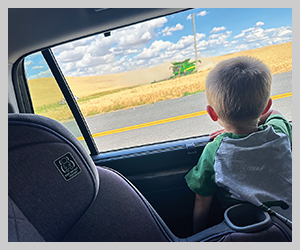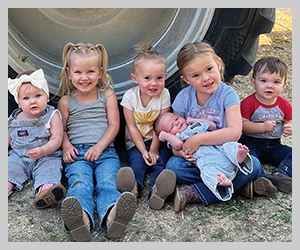When flour was sacked New exhibit at the MAC examines art in the form of packaging
2022March 2022
By Trista Crossley
Editor

It’s usually the items inside a sack that are interesting, but a new exhibition at the Northwest Museum of Arts and Culture (MAC) is taking a look at what the sack itself has to say.
Golden Harvest: Flour Sacks from the Permanent Collection will be on display through Oct. 30, 2022, and features 40 to 50 flour sacks from around the region. The sacks date from about 1900 to the 1940s, a time when modern advertising was starting to be developed. The flour sacks were a way for mills to promote themselves or a specific brand of flour. Most of the collection came from a 1972 donation when one of the last operating flour mills in Spokane closed. As far as the museum knows, this is the first time the collection has been displayed to the public.
“The flour sacks provide such a fascinating window into the early flour milling and wheat growing industries in this region,” said Valerie Wahl, recently retired collections curator for the MAC. “That period of time covered so much change in agricultural methods, flour milling methods and transportation. There was so much happening, and the sacks give a peak into that.”

Some of the 40+ flour sacks that are currently on display at the Northwest Museum of Arts and Culture. ©2022 Dean Davis
Thanks to its railroad links and placement next to some of the most fertile, wheat-growing regions in the U.S., Spokane has a long history in the flour milling industry. In fact, according to Dana Bowne, an independent textile researcher who did the research for the exhibition and wrote the script, Spokane was considered the seventh largest milling center in the U.S. around the turn of the 20th century. She said the exhibition is designed to make people aware of how important the wheat industry has been—and still is—to Spokane.
“When I first opened this box of flour sacks, I was intrigued. Then, the more I got into it, the more I saw how the story affected so much of Washington state’s growth and the region. I was surprised at how far reaching it was,” Bowne said.
Flour sacks began replacing barrels as flour containers in the later 1800s, when the sewing machine made it possible to sew a sturdy sack that could hold flour. Flour sacks dominated the industry until the 1940s when paper sacks, which were introduced 20 years earlier, became the main form of packaging.
Many of the sacks were meant for exporting flour to other countries, and Bowne said the imagery on the sacks bound for those countries is much different than the sacks bound for domestic use.
“What I find especially exciting are the sacks that were meant for export. Today, up to 90 percent of Washington wheat is exported, but I didn’t realize that they started shipping flour out of Washington in the 1860s,” Bowne said. “We’ve got about two dozen sacks meant for export to other countries—China, Japan, the Philippines and El Salvador—and I think they all date from 1912-1932. The graphics are fascinating. The archives have quite a bit of information about the export industry, and I didn’t realize just how long it had been such an important part of the wheat industry.”
Part of the exhibition will focus on the use of flour sacks as clothing and other household items, which was especially common in rural areas. In the 1920s, when paper sacks began to make in-roads into the milling industry and threaten one of the cotton industry’s sources of revenue, Bowne said there was a real effort to reach out to urban women via pamphlets and publications promoting the use of flour sacks. The Depression and the Dust Bowl years accelerated this trend.

Flour sacks were often used as clothing and other household items, especially by rural women. ©2022 Dean Davis
“We actually have a dress from the 1880s, and the bodice is lined with pieces of sacks from the very first roller mill in Washington Territory, which was here in Spokane. We have quilts. We have a nightgown, an apron and a dishtowel, all made out of recycled flour sacks,” she said.
Other parts of the exhibition include sections on wheat farming, wheat milling and artwork inspired by wheat country. Artwork and vintage photographs from the MAC’s archive and the Jordan Schnitzer Museum of Art at Washington State University will enhance viewers’ experience.
“It (the show) could have been just about the flour sacks, but there’s so much more to the story that it really became much more multilayered in terms of the content and the Eastern Washington story,” Wahl said.
One of the things that surprised Bowne as she began her research was how competitive and cut-throat the milling industry was. In the late 1800s, California was the major supplier of flour to Asia until Northwest mill owners muscled their way in. In those days, business was done by telegram, mainly to brokers in Hong Kong. The telegrams were easily monitored, so Spokane mill owners used a secret code.

In order to confuse the competition, Spokane flour mill owners often sent coded telegrams to brokers in Hong Kong to arrange shipments. ©2022 Dean Davis
“You would specify the date and how many bushels were being shipped, how many sacks, the brand of flour, all in a code. You wouldn’t be able to understand the telegram if you didn’t have the code,” Bowne said. “That was fascinating when I found those. So we have some of those code books on display, and a few pages are open so you can see how it worked.
“Obviously, Washington’s wheat farmers have always been dependent on weather, but they’ve also been dependent on the international market from the beginning, and that was a real surprise. I thought that was a more contemporary issue, but it turns out, it’s really been the situation all along, except for some interruptions, like during war.”

Part of the exhibit covers wheat farming in Eastern Washington, including this well-worn pair of boots.
Besides a better understanding of the importance of the wheat and the flour milling industry in the state and regional economy, Bowne and Wahl hope visitors will also come away from the exhibition with a appreciation for the artistic quality of the flour sacks as well as the works of art that are on display.
The Northwest Museum of Arts and Culture is open Tuesday through Sunday, 10 a.m. to 5 p.m., and every third Thursday from 10 a.m. to 9 p.m. The museum is at 2316 West 1st Avenue in down-town Spokane’s historic Browne’s Addition. For more information on the museum and the exhibition, visit their website at northwestmuseum.org.












